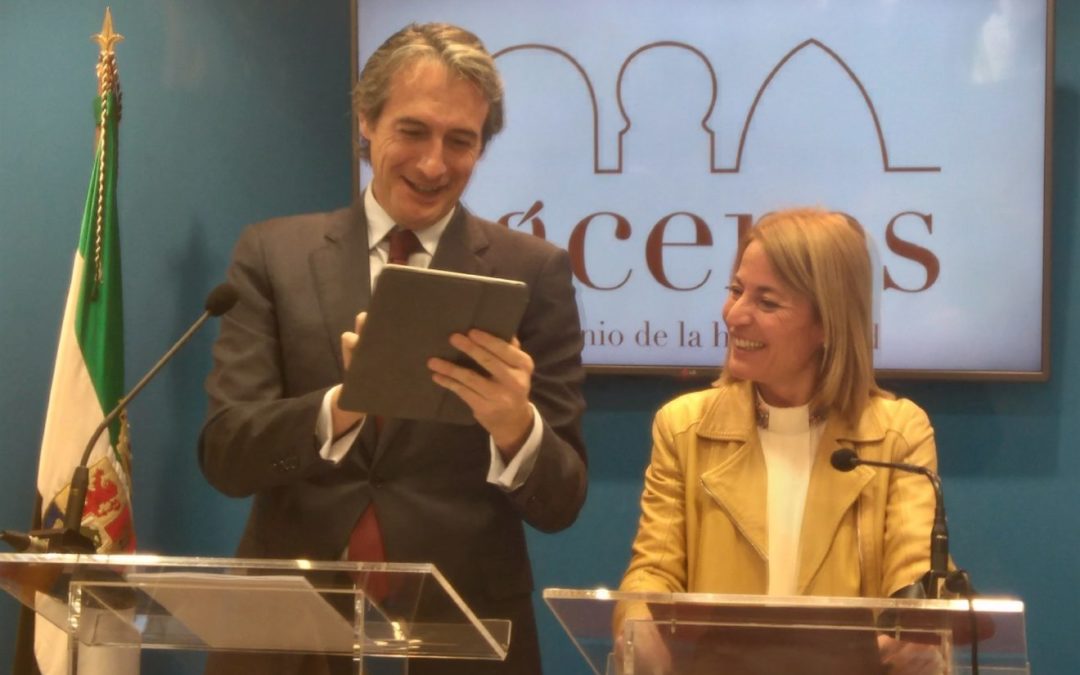De la Serna has indicated that the percentage of execution of the work in the section from Plasencia to Badajoz is already around 60 percent, since of the 1,473 million euros of total expected investment, as of October 31 of last year they had already been 971 million executed, and “in these months much work has been carried out,” he said.
As for the stations of the cities, the minister has indicated that the comprehensive renovation of all of them will be put out to tender, with a global investment of 6 or 7 million euros, “so that they are conditioned and prepared for the arrival of the high speed”.
The minister, who visited Cáceres this Thursday to learn about actions that Development is carrying out in the preservation of the city’s architectural heritage, has indicated that the Government “is giving maximum speed” to the works of the Extremaduran train and has broken down the march of the projects and the state of execution of the different sections.
Thus, in the section from Madrid to Oropesa (Toledo), with an expected investment of 1,120 million euros, the writing of the informative study will be awarded next week to advance in the definition of the alternative for the connection of the Extremaduran bird in the section Talayuela-Plasencia.
Between these two towns, there were two stretches tendered and “before summer” the work will be finished, and in three other stretches the projects are being drafted and “they will be put out to tender in a few months”, such as Casatejada-Toril, Toril-Río Tiétar, and Río Tiétar-Malpartida de Plasencia.
It is also “at the gates of drafting the projects” of the other two remaining sections that are Arroyo de Santa María-Navalmoral and Malpartida de Plasencia-Fuentidueñas Station. The opening of bids for the second section is scheduled for February 13, De la Serna said, noting that the drafting of the 28.8-kilometer Navalmoral de la Mata-Talayuela section has also been awarded.
“We have given a huge push to the works these months,” said the person in charge of Public Works, who also mentioned that work is being done on the drafting of the dual-track project between Plasencia-Cáceres-Mérida, although there are already areas in execution with infrastructures that were paralyzed as bridges that have “been retaken”.
Regarding the conventional train line, the minister announced that the action in Humanes and Monfragüe has already been completed, where 60 million euros have been invested and whose works will conclude in March. Like the Mérida-Puertollano line, which has maintained its “commitment” to comprehensively renovate the road together with electrification, with an expected investment of 382 million euros.
In this line, the bidding for the work is scheduled in the next month for two sections that go from Cabeza del Buey to Castuera, for 20 million euros and with a term of 14 months of execution, and Guadalmez-Los Pedroches with 22 million investment and 11 months of execution. “We are fulfilling the commitments,” he reiterated.
As for the logistics platform in south-west Europe, located in Badajoz, he has indicated that the agreement with ADIF to tender the works in this first semester of 2018 is about to be closed and with an investment of 12 million euros.
INCIDENCES IN THE TRAINS
Regarding the incidents suffered by the Extremaduran trains, De la Serna defended that Renfe “has been taking measures” to correct these problems that “have significantly decreased”, but acknowledges that “unfortunately” faults continue to occur because, also in the rest of the country, “there are railway incidents every day”.
In relation to this matter and to questions from the media about the intention of the Extremadura Regional Government to renegotiate the agreement it has with Renfe, which paid four million euros to maintain 14 railway routes as a public service obligation (OSP), the Minister recalled that the agreement implies that the deficit of what Renfe is supposed to provide that service is covered.
“The Board that previously paid four million euros is now going to pay only three, but if it considers that there are other services that must be provided and paid for by political decision, we have nothing to say, but it must take over one hundred percent of the cost of the service ”, he emphasized, who considered it good news that a new line such as OSP has been incorporated in Extremadura.
FROM AVE TO EVA
The minister has also referred to the new high-speed service that Renfe will put into operation in the first four months of next year and that will start operating on the Madrid-Barcelona line. It will be called EVA and the price of the ticket will be between 20 and 25 percent cheaper than that of the AVE.
“It is another different concept of train adapted to the needs of users with intelligent technology and specific services for each situation,” said De la Serna, who defended that the Spanish AVE “works” but, given the possibility that foreign companies they can start operating next year in the country from 2020 “we have to make a qualitative leap” in the railway offer.
Thus, it has classified this new EVA as a “fresh” and “competitive” service that will act as a “laboratory” train to find out the response of travelers. The Madrid-Barcelona line has been chosen because it is the one that has the most demand and to experiment on the product. “If it works out well, the intention is for it to be extended to the entire network because we would incorporate a different new service, but nothing has been planned yet,” he concluded.
SOURCE: DIGITALEXTREMADURA.COM


